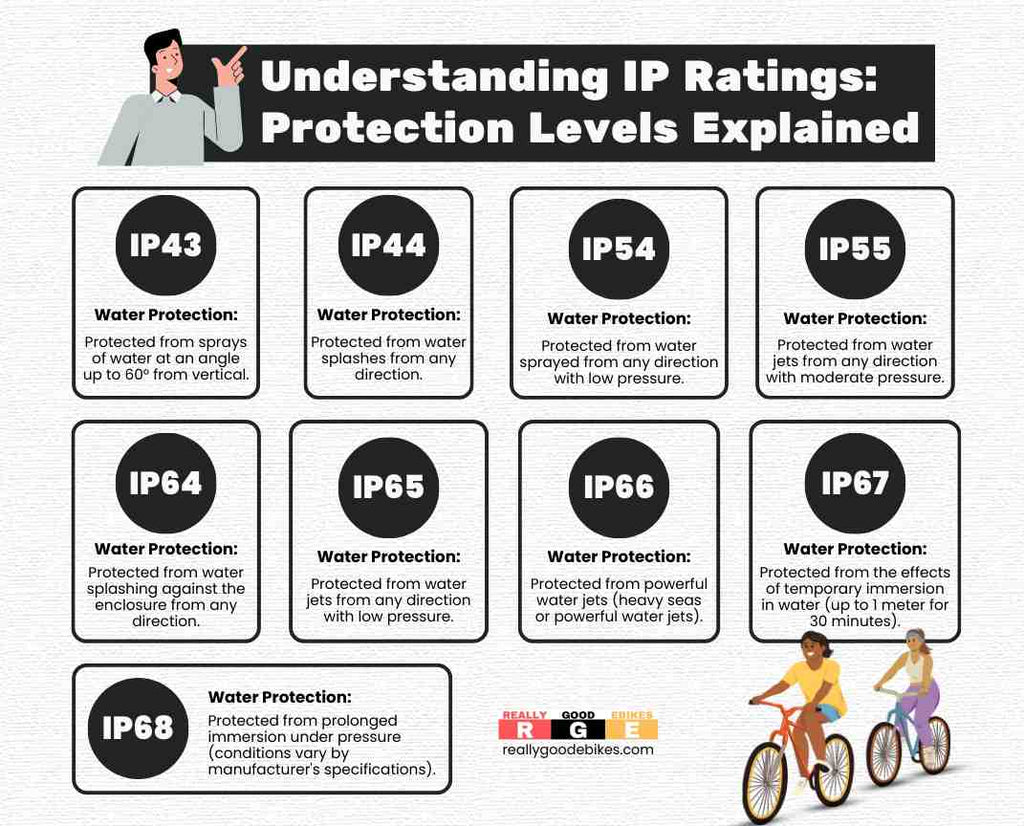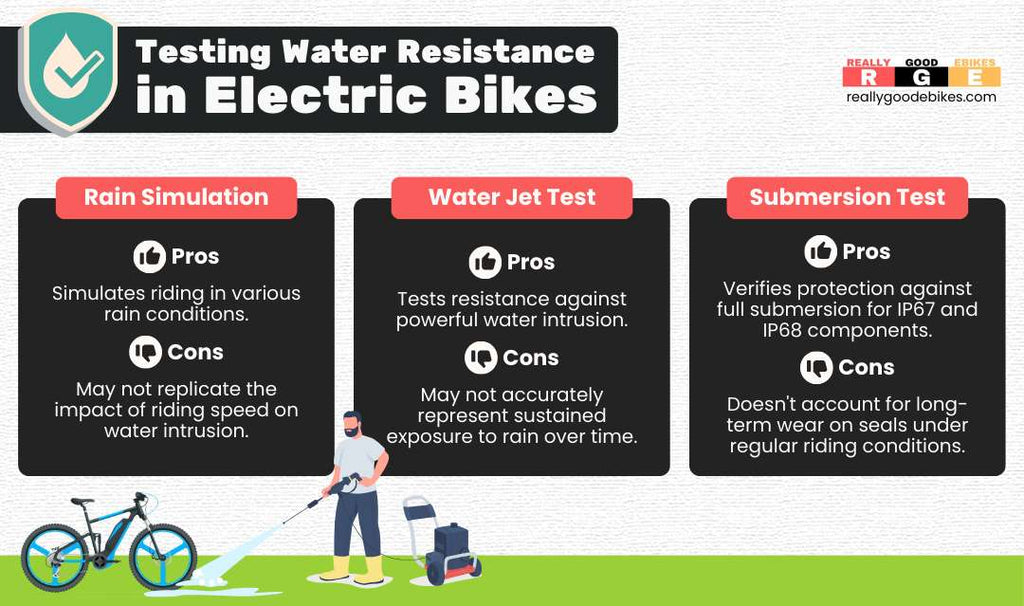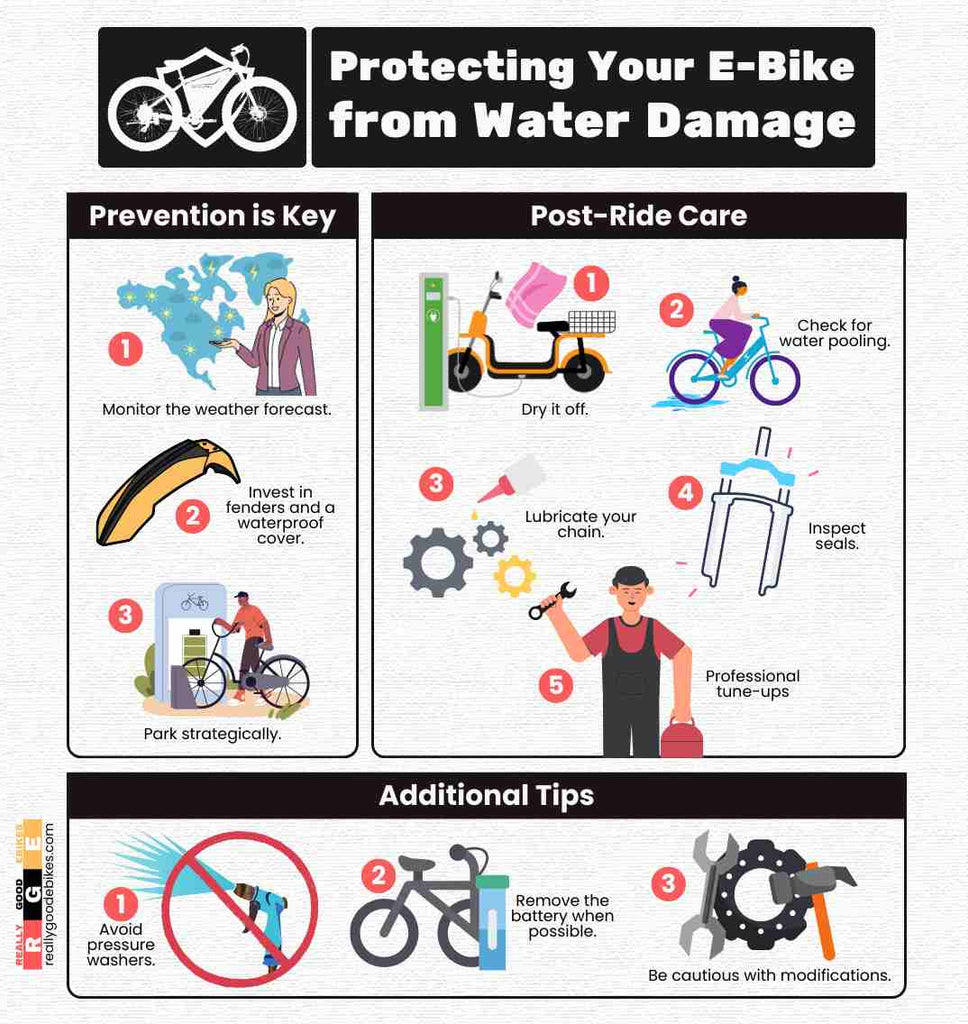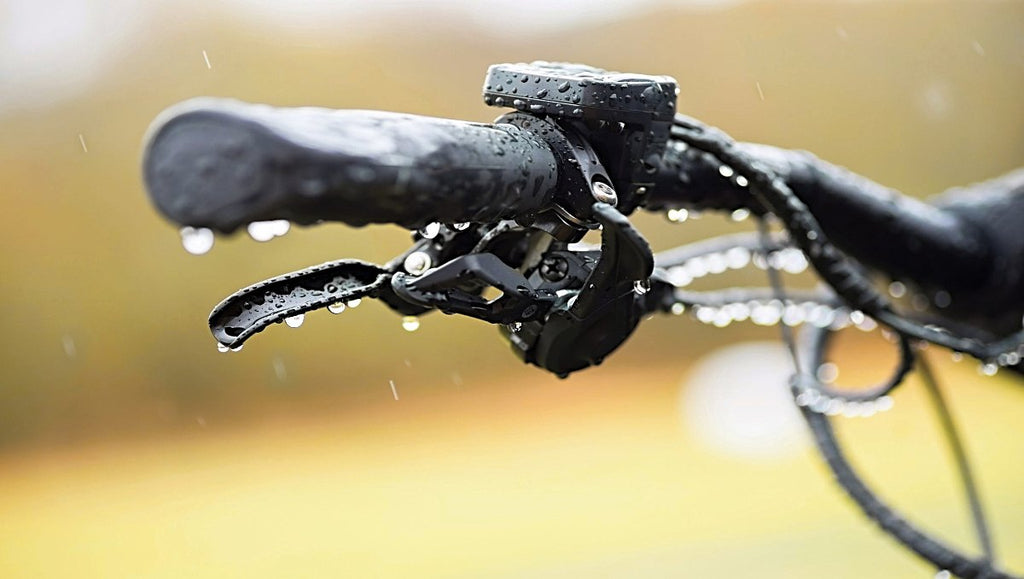Your Cart is Empty
Menu

Are E-Bikes Waterproof? Understanding Their Water Resistance
October 24, 2025

Electric bikes offer a sustainable alternative to traditional transportation, catering to eco-minded city dwellers and adventure seekers alike. However, the increasing reliance on electric bikes brings up a crucial question for riders, especially those in rainy climates or who enjoy exploring diverse weather conditions: Are ebikes waterproof? This matters especially for people in places with lots of rain or adventurers riding in different weather conditions.
Key Takeaways:
- E-bikes are water-resistant, not waterproof. They can handle light rain and splashes but not heavy rain or submersion.
- Understanding the Ingress Protection (IP) ratings of your e-bike's components, such as the battery, motor, and display, can help gauge their performance against water and dust.
- Regular maintenance, including inspections and cleaning, is vital for preserving the water resistance of your e-bike.
- If your e-bike gets wet, power it down immediately, remove the battery if possible, and dry all components carefully.
This article breaks down the water resistance of e-bikes, exploring what you need to know to protect your investment and ride worry-free in less-than-ideal weather.
How Water Resistant Are Electric Bikes?
Most modern electric bikes are built to handle everyday moisture like light rain, splashes, and puddles without issue, thanks to protective designs around their electrical components. However, they’re not meant to be submerged or exposed to heavy water for long periods.
A key way to understand an e-bike’s water resistance is by checking its Ingress Protection (IP) rating, which indicates how well the bike’s parts are sealed against dust and water. It uses two numbers:
-
First digit: Protection against solids (0-6, with 6 being the highest dust resistance).
-
Second digit: Protection against liquids (0-8, with 8 being full submersion).
When checking how water-resistant an electric bike is, keep in mind that IP ratings often apply to each part separately—not the whole bike. So, some components might handle dust and water better than others.
Here's a breakdown of IP ratings you'll commonly find on key e-bike components:

Here's a table outlining common IP ratings you might encounter on electric bikes, along with explanations of the protection level for both dust and water:

Factors That Impact the Water Resistance of Electric Bikes
Not all e-bikes are created equal when it comes to battling the elements. Several key factors influence how much rain or splashing your e-bike can withstand:
Materials matter: Components made of aluminum or stainless steel inherently offer more rust resistance than other metals. Additionally, plastic and rubber seals are crucial in keeping water out of sensitive areas where electronics reside.
Designed with protection in mind: Top-notch e-bikes have well-designed enclosures that minimize exposed wiring and utilize high-quality seals around connections. Look for casings or accessories that completely cover the battery and motor, with tight seam construction to limit water entry points.
The manufacturer's role:Reputable e-bike manufacturers invest in thorough testing and rigorous quality control to ensure their products meet their claimed water resistance levels. Choosing well-known brands often gives you greater peace of mind, as they have a reputation to uphold.
Maintenance is key: Even the most water-resistant e-bike will only last for a while if neglected. Regularly inspecting seals for wear, drying your bike after wet rides, and being mindful of storage conditions greatly prolong its life and keep water at bay.
Testing Water Resistance in Electric Bikes
E-bike manufacturers assign IP ratings after testing components in controlled environments, using water jets and brief submersion to simulate conditions like rain and puddles. These tests help ensure components meet the expected water resistance levels. However, real-world factors such as road debris, vibration, and temperature changes can put extra stress on seals and parts. Therefore, IP ratings are useful indicators but not guarantees of complete protection in all weather conditions.

Can You Ride an Electric Bike in the Rain?
You can ride an electric bike in the rain, but with important caveats. Modern e-bikes are built to be water-resistant, meaning they can handle light rain and road spray without issue. However, a crucial distinction exists between water-resistant and waterproof. Riding in a heavy downpour increases the risk of water forcing its way into seals and damaging sensitive electrical components like the motor or battery. It's best to avoid prolonged exposure to heavy rain and to use fenders to minimize water and dirt kicking up onto the bike.
The key to riding in wet weather safely is to understand your e-bike's limitations. Never, under any circumstances, should you submerge your e-bike in water by riding through deep puddles, flooded streets, or streams. Doing so can cause catastrophic and irreversible damage. Beyond simply avoiding deep water, remember that a wet ride requires extra care. Proper post-ride maintenance is essential to prevent long-term damage.

Don't let a little rain stop you from riding. Protect your e-bike's display and battery with our top-ratede-bike rain cover.
Protecting Your E-Bike from Water Damage
Taking care of your e-bike investment goes beyond just cleaning the frame. Here are crucial measures to protect it from water damage:
- Don't get caught in a downpour unprepared. Check the weather before you head out.
- Fenders greatly reduce the water and grime kicked up toward the motor and battery.
- If storing your e-bike outside, a cover adds another layer of defense against moisture and dust.
- If possible, park your e-bike indoors or under a sheltered area when not in use.
- Wipe down your e-bike with a clean cloth after wet rides, especially around electrical components.
- Pay attention to areas where water might collect and gently dry them.
- Regular lubrication keeps things moving smoothly and helps prevent rust.
- Check the rubber seals around the battery, motor, and display for cracks or wear. Replace them if needed.
- A yearly checkup can help identify potential water intrusion points before they become big issues.
- The force can blast water past seals. Use a gentle hose if needed.
- If you won't use the e-bike for a while (or in very wet weather), remove and store the battery indoors in a dry place.
- Any aftermarket changes that expose wiring or seals could increase water vulnerability.

What to Do If Your Electric Bike Gets Wet
The weather can be unpredictable, and even a well-protected e-bike might get caught in a downpour or accidentally submerged. If this happens, your immediate action should be to power off your e-bike immediately to prevent electrical shorts. Then, remove the battery if possible and store it in a dry, well-ventilated area. Gently wipe down the entire bike with a soft, absorbent cloth. Avoid shaking the bike or using harsh heat sources for drying.
If your display got heavily soaked, remove it (if possible) and let it dry naturally. The motor should dry thoroughly before reconnecting power. Ensure any water drains out. Inspect the battery compartment for moisture. Dry it gently with a cloth. If water gets into the battery case, do not attempt to power it on; seek a professional assessment immediately.
Important Notes:
- Never power on a wet e-bike. This could cause serious electrical issues.
- Avoid compressed air. It can force water deeper into sensitive areas.
- Time is key. The sooner you address water exposure, the better your chances of preventing long-term damage.
Insurance and Warranty Considerations for Water Damage

When it comes to water exposure, many riders assume that their e-bike warranty or insurance policy will automatically cover damage. Unfortunately, that’s not always the case. Most standard manufacturer warranties are designed to cover defects in materials or workmanship, not issues caused by external factors like heavy rain, flooding, or improper cleaning methods. Insurance can offer a valuable safety net where warranties fall short. Some specialty e-bike insurance providers now include water damage protection, especially for riders who live in regions with frequent rainfall or flooding risks. Comprehensive policies may cover:
-
Battery and motor replacement due to water exposure
-
Electronics repair from short-circuits caused by moisture
-
Frame or component damage resulting from rust or corrosion
If you’re considering insurance, make sure to ask whether water-related incidents are covered, as not all providers include this in their standard policies. In some cases, riders may need to purchase additional coverage or an extended plan for full protection.
Conclusion
Electric bikes offer a fantastic way to get around, but it's important to understand they aren't built for underwater adventures. They are designed with water resistance in mind, and with proper care, most can handle light rain and the occasional splash. However, heavy rain, puddles, and full submersion can spell trouble for sensitive electronics.
By understanding the limits of your e-bike's water resistance, taking precautions in wet weather, and diligently maintaining those seals and components, you'll enjoy your electric ride for many miles to come. Remember, a little care protects your investment and ensures your e-bike is always ready to roll, rain or shine!
E-Bike Water Resistance: FAQs
Is there a waterproof e-bike?
No e-bike is completely waterproof. However, some models have higher IP ratings, making them more water-resistant. Always check the specific ratings of the battery, motor, and display before buying if you anticipate frequent wet-weather riding.
How waterproof are e-bike batteries?
Most modern e-bike batteries have IP ratings of IP65 to IP67. This means they are dustproof and can withstand water jets or brief immersion. However, avoiding prolonged exposure to heavy rain or submersion is best.
Should I cover my e-bike battery?
Covering your e-bike battery can offer additional protection against moisture, especially when storing your bike outside. Choose a cover designed for e-bike batteries to ensure proper ventilation and fit.
Can I wash my e-bike with a hose?
A gentle rinse might be okay, but never use a pressure washer. Focus on rinsing off mud or dust, and avoid spraying water directly at the battery, motor, or display.
Leave a comment
Comments will be approved before showing up.
Also in Really Good Ebikes: Electric Bike Blog
Your are successfully subscribed for email notifications.
Notify me when available
We will send you a notification as soon as this product is available again.
Your email is required
We don't share your email with anybody
x


